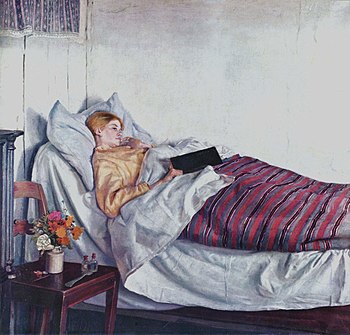Our website is made possible by displaying online advertisements to our visitors.
Please consider supporting us by disabling your ad blocker.
Sickness behavior

Sickness behavior is a coordinated set of adaptive behavioral changes that develop in ill individuals during the course of an infection.[1] They usually, but not always,[2] accompany fever and aid survival. Such illness responses include lethargy, depression, anxiety, malaise, loss of appetite,[3][4] sleepiness,[5] hyperalgesia,[6] reduction in grooming[1][7] and failure to concentrate.[8] Sickness behavior is a motivational state that reorganizes the organism's priorities to cope with infectious pathogens.[8][9] It has been suggested as relevant to understanding depression,[10] and some aspects of the suffering that occurs in cancer.
- ^ a b Hart, BL (1988). "Biological basis of the behavior of sick animals". Neuroscience and Biobehavioral Reviews. 12 (2): 123–137. doi:10.1016/S0149-7634(88)80004-6. PMID 3050629. S2CID 17797005.
- ^ Kent, S.; Bluthe, R. M.; Dantzer, R.; Hardwick, A. J.; Kelley, K. W.; Rothwell, N. J.; Vannice, J. L. (1992). "Different receptor mechanisms mediate the pyrogenic and behavioral effects of interleukin 1". Proceedings of the National Academy of Sciences of the United States of America. 89 (19): 9117–9120. Bibcode:1992PNAS...89.9117K. doi:10.1073/pnas.89.19.9117. PMC 50076. PMID 1409612.
- ^ Exton, M. S. (1997). "Infection-Induced Anorexia: Active Host Defence Strategy". Appetite. 29 (3): 369–383. doi:10.1006/appe.1997.0116. PMID 9468766. S2CID 10465902.
- ^ Murray, M. J.; Murray, A. B. (1979). "Anorexia of infection as a mechanism of host defense". The American Journal of Clinical Nutrition. 32 (3): 593–596. doi:10.1093/ajcn/32.3.593. PMID 283688.
- ^ Mullington, J.; Korth, C.; Hermann, D. M.; Orth, A.; Galanos, C.; Holsboer, F.; Pollmächer, T. (2000). "Dose-dependent effects of endotoxin on human sleep". American Journal of Physiology. Regulatory, Integrative and Comparative Physiology. 278 (4): R947 – R955. doi:10.1152/ajpregu.2000.278.4.r947. PMID 10749783. S2CID 10272455.
- ^ Maier, SF; Wiertelak, EP; Martin, D; Watkins, LR (1993). "Interleukin-1 mediates the behavioral hyperalgesia produced by lithium chloride and endotoxin". Brain Research. 623 (2): 321–324. doi:10.1016/0006-8993(93)91446-Y. PMID 8221116. S2CID 40529634.
- ^ Dantzer R, Kelley KW (February 2007). "Twenty years of research on cytokine-induced sickness behavior". Brain Behav. Immun. 21 (2): 153–160. doi:10.1016/j.bbi.2006.09.006. PMC 1850954. PMID 17088043.
- ^ a b Kelley, KW; Bluthé, RM; Dantzer, R; Zhou, JH; Shen, WH; Johnson, RW; Broussard, SR (2003). "Cytokine-induced sickness behavior". Brain, Behavior, and Immunity. 17 (Suppl 1): S112 – S118. doi:10.1016/S0889-1591(02)00077-6. PMID 12615196. S2CID 25400611.
- ^ Johnson, R. W. (2002). "The concept of sickness behavior: A brief chronological account of four key discoveries". Veterinary Immunology and Immunopathology. 87 (3–4): 443–450. doi:10.1016/S0165-2427(02)00069-7. PMID 12072271.
- ^ Dantzer, Robert (May 2009). "Cytokine, Sickness Behavior, and Depression". Immunology and Allergy Clinics of North America. 29 (2): 247–264. doi:10.1016/j.iac.2009.02.002. PMC 2740752. PMID 19389580. Retrieved 23 February 2015.
Previous Page Next Page


